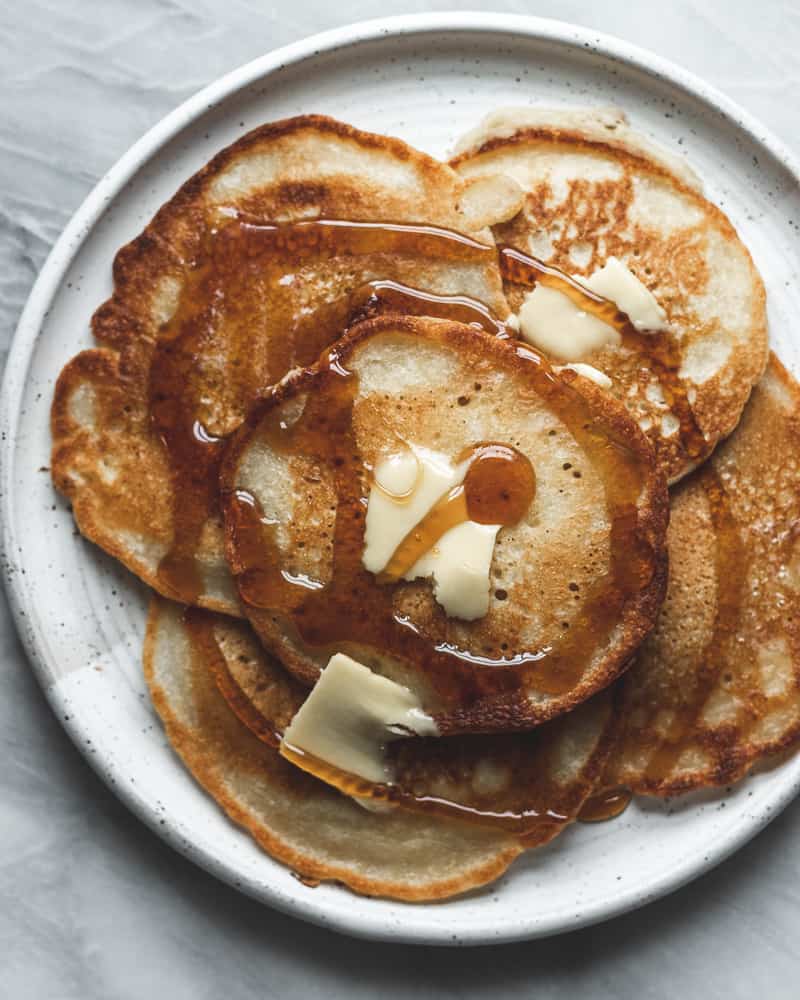Wild Thistle Kitchen: Overnight Sourdough Pancakes
By • March 31, 2022 One Comment 1766

Pancakes are a beloved weekend tradition in many homes and ours is no exception. Making them is one of the coziest ways to get the morning going and it really makes the weekend special. I used to be so amazed at how my grandma could mix up pancake batter without looking at a recipe. I was in awe of the fact that she had made them so many times that she just knew. While she never made sourdough pancakes, these still remind me of her. These Overnight Sourdough Pancakes begin with an overnight, room-temperature ferment. This not only adds a lovely, balancing tang to the pancakes, but also provides all of the great gut-health and digestibility benefits of sourdough. Then the next morning, a few more ingredients are added right before cooking. The process is so simple and so rewarding.
I’m The First to Admit That Sourdough Can Be Intimidating…
But it doesn’t have to be! There’s a lot of rigid scheduling, measuring, weighing, fussing over the hydration and the perfect blend of flours — bonus points if you grind your own wheat berries. I don’t mean to sound snarky, but this recipe has none of that — I just don’t cook that way. Some will frown upon those of us who cook and bake without using a scale for everything, but I am totally unapologetic. I do use a scale in my kitchen, and it does have a place in some recipes, but this overnight sourdough pancake recipe is a very simple, very friendly, no-fuss sourdough recipe.
For this recipe, I use unfed starter, either room temperature or straight out of the fridge, what some might call “sourdough discard” – although I don’t really ever discard my starter. As soon as you add the sourdough starter to the other pancake ingredients, it becomes active and bubbly right before your eyes as it hungrily feeds on the flour and honey. It’s like magic and it makes me smile every time.
How to Cook These Sourdough Pancakes
I like to fry these pancakes in my cast iron skillet — nice and hot with plenty of coconut oil. I love the flavor the coconut oil lends and I also love the crispy edges the pancakes get from both the cast iron and the coconut oil. We do have an electric griddle which is great for pancakes, but I really prefer the cast iron for these.
Some Resources for the More Laid-Back Sourdough Enthusiasts
These are both from Lisa at Farmhouse on Boone. I’m a big fan of hers – and of her blog and Youtube Channel. She has such a laid-back approach to sourdough that really opened my eyes and made me love the process so much more.
How I ACTUALLY use my sourdough starter
Maintaining and Feeding a Sourdough Starter
There are lots of other great sourdough resources, and I’ve linked to several in my Sourdough Pizza Crust post. I think the bottom-line with sourdough is, you have to figure out what works best for you and for your style of cooking and baking. It took some trial and error, some frustration, and a long break, but I finally landed on my style and I love it. I encourage you to do the same. I’m always around to help (or try to help) if you have any questions.
I Hope You Enjoy These Overnight Sourdough Pancakes
My husband LOVES pancakes, and these have become his new favorite variety. He enjoys them the way he grew up eating pancakes with his dad: with a fried egg sandwiched in the middle of two pancakes and King Syrup drizzled on top. I love them with good, salted butter and maple syrup, but also the way my sweet granny taught me: topped with plain yogurt and sour cherry jam. So, so good….
Ingredients:
For the Overnight Ferment:
- 1 cup sourdough starter, unfed
- 1 cup milk *see notes
- 1 and ¼ cups unbleached all purpose flour *see notes
- 2 teaspoons honey
For the Final Batter:
- ¼ cup melted butter or coconut oil
- 1 egg
- 1 teaspoon vanilla extract or paste
- ¼ teaspoon salt
- 1 teaspoon baking powder
- ½ teaspoon baking soda
For Frying:
- Coconut oil (or oil/butter of choice)
For full recipe and instructions go to https://wildthistlekitchen.com/overnight-sourdough-pancakes/.


I read somewhere around 35 years ago that thistle can be used as a starter for sour dough. Do you know what kind of thistle and what part(s) and process?